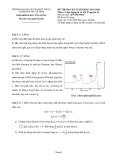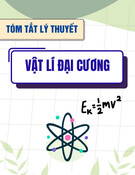
MINISTRY OF SCIENCE AND TECHNOLOGY MINISTRY OF EDUCATION AND TRANING
VIETNAM ATOMIC ENERGY INSTITUTE
⋆⋆⋆⋆⋆
Pham The Song
STUDY OF FINITE-SIZE EFFECTS IN TWO
SEGREGATED BOSE-EINSTEIN CONDENSATES
WITH SPATIAL RESTRICTION
Major: Theoretic and mathematic physics
Code: 62.44.01.03
DRAFT SUMMARY OF THE DOCTOR THESIS
Hanoi, 2017

Abbreviations
Signs English Vietnamese
BEC Bose-Einstein conden-
sate ngưng tụ Bose-Einstein
BECs two segregated Bose-
Einstein condensates
ngưng tụ Bose-Einstein
hai thành phần phân
tách
CE Canonical ensemble tập hợp chính tắc
GCE Grand canonical ensem-
ble tập hợp chính tắc lớn
DPA Double-parabola approx-
imation gần đúng parabol kép
MDPA Modified double-
parabola approximation
gần đúng parabol kép mở
rộng
GP Gross-Pitaevskii Gross-Pitaevskii
GPE(s) Gross-Pitaevskii equa-
tion(s)
(hệ) phương trình Gross-
Pitaevskii
TIGPEs
Time-independent
Gross-Pitaevskii equa-
tions
hệ phương trình Gross-
Pitaevskii không phụ
thuộc thời gian
TPA Tripple-parabola approx-
imation gần đúng ba parabol
MFA Mean-field approxima-
tion
gần đúng trường trung
bình

2
INTRODUCTION
1. The research subject
By applying the DPA method, J. O. Indekeu and his partner stud-
ied surface tension and wetting phase transition in the infinity system
of BECs and have gained lots of important results (Phys. Rev. A 91,
033615, (2015)). However, the influence of spatial restriction on physics
properties of this system had not mentioned yet, while study the con-
fined space effects of quantum systems meaningful to modern technology.
That is the reasons why we choose the subject Study of finite-size ef-
fects in two segregated Bose-Einstein condensates with spatial
restriction.
2. History of problem
The Nobel prize 2001 in physics was awarded to E. A. Conell and
W. Ketterle as a result of the first successful experiment of BEC (1995),
which attracted attention of many scientists in the world.
Based on the MFA, the GPE (s) are found by E. P. Gross and L. P.
Pitaevskii, which is the most important development in theory of BEC.
Using order parameters linearization method of P. Ao and S. T.
Chui, J. O. Indekeu and his partner has found DPA method. Accord-
ingly, they investigated analytical solution to GPEs and compared with
its numerical solution in GP theory. From here, the authors calculated
in detail about surface tension and wetting phase transition of infinity
BECs system.
In this thesis, the influence of spatial restriction on the static prop-
erties of BECs system limited by hard walls is studied by means of the
MDPA applied to GP theory.
3. The aims of this thesis
Study the influence of spatial restriction on the static properties of
BECs in ground state.
4. The object, problems, scope of the thesis
•Studying object: The system of BECs confined by one (or two)
hard wall(s).
•Studying problems:
–Find the wave functions of condensates under Dirichlet and
Robin boundary conditions at hard walls;
–Investigate the surface tensions;
–Study wetting phase transition and the influence of space
limitation on the static properties of BECs system.

3
–Propose the experimental verification the finite-size effects
in BECs system.
•Studying scope: System of time-independent BECs at ultra-low
temperature, in GCE and CE.
5. The methods
MFA method, MDPA method, numerical method.
6. The contributions of the thesis
The thesis has many contributions in physics of BECs.
7. The structure of the thesis
Besides introduction and conclusion, this thesis consists of 3 chap-
ters.
Chapter 1. Overview of Bose-Einstein condensate. Theory of BECs.
Chapter 2. Interfacial tension and wetting phase transition in the
system of BECs limited by one hard wall.
Chapter 3. Finite-size effects of interfacial tension in the system of
BECs limited by two hard walls.

4
Chapter 1. Overview of Bose-Einstein condensate. Theory
of BECs.
1.1. Overview of Bose-Einstein condensate
1.1.1. Bose-Einstein condensate state
BEC is a state of a boson gas cooled to critical temperature Tcap-
proximately 0(K). Under such condition, a large ratio of bosons occupy
the lowest energy level.
Particle number at condensated state:
N(ε= 0) = N−N(ε > 0) = Nh1−T
Tc3/2i,
here Nis total particle number of system.
1.2. The Gross-Pitaevskii equation and hydrodynamic equa-
tions of condensated wave function
a. The Gross-Pitaevskii equation
+ The time-dependent GPE
i~∂tψ=−~2
2m∇2ψ+U(~x)ψ+G|ψ|2ψ.
+ The time-independent GPE
−~2
2m∇2ψ(~x) + U(~x)ψ(~x) + G|ψ(~x)|2ψ(~x) = µψ(~x).
b. Healing length of condensated wave function:ξ=~
√2mGn .
c. The hydrodynamic equations of condensated wave function
+ The continuity equation of condensate:
∂tn+∇(n~v) = 0,
in which n=|ψ|2,~v =i~
2mn ψ∇ψ∗−ψ∗∇ψis velocity of condensate,
~
j=i~
2ψ∇ψ∗−ψ∗∇ψis density of momentum.
+ The equations of motion:
∂t|ψ0|2=−~
m∇(|ψ0|2∇φ)
and
∂tφ=−1
~
δE
δn .











![Bộ câu hỏi lý thuyết Vật lý đại cương 2 [chuẩn nhất/mới nhất]](https://cdn.tailieu.vn/images/document/thumbnail/2025/20251003/kimphuong1001/135x160/74511759476041.jpg)
![Bài giảng Vật lý đại cương Chương 4 Học viện Kỹ thuật mật mã [Chuẩn SEO]](https://cdn.tailieu.vn/images/document/thumbnail/2025/20250925/kimphuong1001/135x160/46461758790667.jpg)













